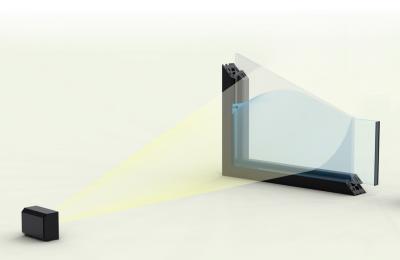If anything changes in front of the pane, or someone sneaks up to it, an alarm signal is sent to the security guard.
Your cat is going to have a lot of fun with that, right? Luckily, threshold for the alarm can be set, so that small moving objects do not trigger an alarm.
The principle: The invisible light of a UV lamp "illuminates" the window panes and generates fluorescent radiation in the coating. This radiation is channeled to the edges of the window, where it is detected by sensors. Simple applications require only one sensor. Similarly to a light barrier, if someone steps into the light of the lamp less light reaches the coating and less fluorescent radiation is produced. If several sensors are installed on all four sides of the window frame, conclusions can be drawn from the data as to how fast and in what direction an object is moving. Its size can also be estimated by the sensors.

The invisible light of a UV lamp "illuminates" the window panes and
generates fluorescent radiation in the coating. This radiation is detected
by sensors in the edges of the window. Credit: Fraunhofer IAP
"The glass is coated with a fluorescent material," explains IAP group manager Dr. Burkhard Elling. "The coating contains nanoparticles that convert light into fluorescent radiation."
Likewise, the sensors do not react to light from passing cars, as the researchers at FIRST have developed a software application that can interpret different light signals. This enables the system to easily distinguish between the frequency of the UV lamp and the slowly changing light from a passing headlight.
The system has further advantages: it does not infringe on anybody's personal rights, as it only detects the change in radiation, and not who triggered it. It is also cost-efficient, because the coating can be sprayed onto the windows by airbrush or glued on as a film. A demonstrator system already exists, and the researchers now plan to optimize the dyes and their concentration in the coating.





Comments